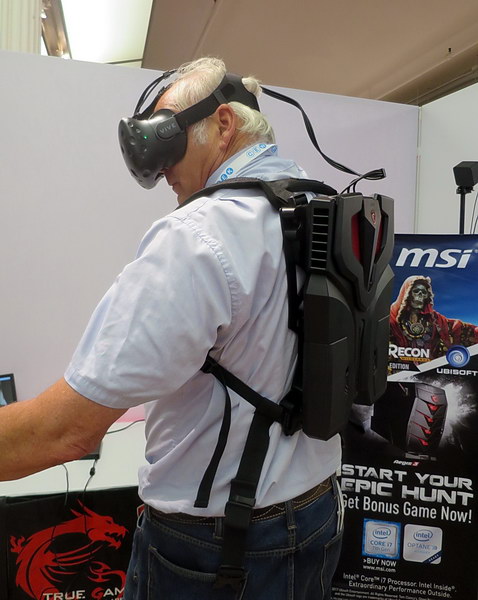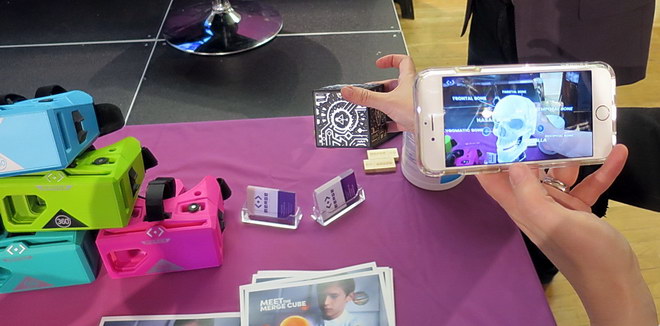I’ve attended CE Week New York for several years now. In the past, it has been organized by the Consumer Technology Association (CTA). The CTA always gave, among other things, a foretaste of the next year’s CES in Las Vegas plus the CTA forecasts for the upcoming holiday shopping season.
This year CE Week, held July 12-13, was “owned and produced by NAPCO Media.” The company had the assistance of DealerScope, ShowStoppers and GetGeeked New York. There was no evidence of cooperation with the CTA and no CES preview. In general, the event was very focused on the “Consumer” end of consumer electronics. After a press-only opening from noon till about 2:00, increasing numbers of “Influencers” were admitted and at 5:00 the general public was admitted to the talks and the show floor.
The general public lined up around the block to get into CE Week in New York. (Photo credit: M. Brennesholtz)
In the one talk I attended, the keynote speaker, had little value. The speaker was John Vaskis, Head of Hardware at Indiegogo, who told us how you can get your hardware invention onto the Indiegogo crowd funding website. I looked briefly at a couple of other talks and they were all just straight product promotion. Another problem with the talks was they were held in the lobby, rather than a separate room, and the noise from the show floor made it very hard to hear the speaker.
There were about 70 exhibitors on the show floor, several of which were showing products of interest to Display Daily readers.
Taiwan-based Micro-Star International (MSI) is a maker of high-performance graphics cards and laptops designed for dedicated gamers. MSI showed their VR One back-pack computer at CE Week and I got to try it out. The VR One, which is available with either a Nvidia GTX1060 or GTX1070 graphics processor, is designed for untethered use with VR HMDs. At CE week, they were demonstrating it with the HTC Vive but the MSI rep said it would work with virtually any HMD, current or future. The VR One was first shown at the Tokyo Game Show in September 2016, but this is the first time a Display Daily contributor has had a chance to try one.
 Meko’s Matt Brennesholtz tries the MSI VR One backpack computer with a HTC Vive HMD. (Photo credit: M. Brennesholtz)
Meko’s Matt Brennesholtz tries the MSI VR One backpack computer with a HTC Vive HMD. (Photo credit: M. Brennesholtz)
The VR One uses a 6th generation Intel Core i7 6820HK processor that is overclocked at the MSI factory. This, along with the GeForce X10 Series graphics processors, allows for a 90 fields per second (FPS) display rate. When I wore the VR One and saw the virtual world in the HTC Vive HMD, this seemed to significantly reduce disorientation I’d felt in other VR HMD gaming systems, including others using the Vive HMD. I believe this is due to the fact that I could move my head and body freely and the graphics system was fast enough so the image on the HMD always matched the body motions with no noticeable latency or smear.
After I had put on the HMD and started the game, the MSI rep handed me two HTC Vive VR controllers. On the HMD, the rep couldn’t be seen but the two controllers showed up as a pair of swords. I reached out and grabbed the two sword handles – no problem and it felt very natural and the controller handles were where the sword handles appeared to be. As I waved the controllers around, I could see the swords move, again with very natural looking motion. While I only wore the unit for about 10 minutes and felt no disorientation during that time, the twin, replaceable batteries are capable of powering the unit for about 1½ hours. I wonder if even the most dedicated VR gamer will be able to wear the system for that long without disorientation or other forms of VR sickness. With the two batteries installed, the unit weighed about 3.6 Kg (7.9 pounds) and was comfortable to wear, at least for 10 minutes.
Of course, the 90Hz frame rate did nothing to reduce the major screen door effect from the HMD displays. When higher resolution HMDs are available, hopefully advances at MSI, Intel and Nvidia will allow follow-on units to the VR One to maintain this 90Hz frame rate.
The VR One computer comes with an HDMI port, a Mini DisplayPort and a Thunderbolt 3 port for transfer speeds up to 40Gbps and multi-display output. According to the rep at CE Week, the system is like a high-performance gaming laptop without it’s own screen or keyboard. MSI says it can be used as a desktop computer and drive three external 4K@60Hz monitors simultaneously. The VR One also had a DC output designed to power the HTC Vive HMD.
The Polaroid POP instant print digital camera was announced at CES and on display at CE Week – on display, but not being demonstrated. While the unit has a built in printer using ZINK zero ink technology, the Polaroid reps were not demonstrating how the camera could print. They did have multiple prints on display said to have been made by the camera. These were about the same size and shape of the old Polaroid instant film, but the prints lacked the vivid colors I remember about the older instant film prints. Even if they couldn’t (or wouldn’t) print them, they Polaroid reps could take pictures and show them on the built-in 3.97” touch-screen LCD. It is said that this unit will be available in time for the holiday selling season at a price of $199 plus $5.00 for a 10-pack of the ZINK paper. I’d give it a pass, though, and recommend using either your smartphone camera or a real camera. When and if you ever want to print, use a good inkjet photo printer.
 Polaroid POP camera with built in printer with some prints. (Photo credit: Polaroid)
Polaroid POP camera with built in printer with some prints. (Photo credit: Polaroid)
Merge VR was at CE week demonstrating it’s Merge Cube. The Merge Cube is a small cube with distinctive patterns printed on all six sides. When you point a compatible smartphone at the Merge Cube, Augmented Reality (AR) software replaces the cube with a “Hologram” of another object. According to the Merge VR rep, they have shipped over 500 development kits and expect a large number of apps to be available when the product is formally introduced. The Merge Cube can be used with either iOS or Android phones and the phones can be viewed directly or installed in a smart-phone based VR HMD, such as the Merge VR/AR goggles. The Merge VR/AR glasses leave the phone camera exposed and allow handling the MergeCube in two hands. When it becomes available, the Merge Cube will retail for less than $200, according to the rep.
 The image of the Merge Cube (center) was converted to a “hologram” of an object and shown on the smartphone display, The object shown depended on the AR App in use and in this case it is a skull for use in an anatomy lesson.. Several sets of Merge VR/AR goggles without the smartphone installed can be seen on the left. (Photo credit: M. Brennesholtz)
The image of the Merge Cube (center) was converted to a “hologram” of an object and shown on the smartphone display, The object shown depended on the AR App in use and in this case it is a skull for use in an anatomy lesson.. Several sets of Merge VR/AR goggles without the smartphone installed can be seen on the left. (Photo credit: M. Brennesholtz)
One major feature of CE week under the CTA was the annual TV shootout. The shootout continued this year under NAPCO, in modified form. Like the talks, however, it did not have a separate room so the noise from the show floor overwhelmed the speaker leading the shootout. I didn’t attend the second and final day of CE Week, so I’ll report on what DealerScope had to say about the shootout results which were announced last thing the second day.
The entrants in this year’s Annual TV Shootout included six different 4K 65-inch models from the top names in the TV industry. The sets being compared were:
- LG’s OLED65G7P OLED
- Sony’s XBR-65Z9D Backlit LCD
- Sony’s XBR-65A1E OLED
- Samsung’s QN65Q9F LED Backlit
- Vizio’s P65E1
- Westinghouse’s WA65UFA1001 Amazon Fire TV Edition
The six units were set up and adjusted by Joel Silver, Founder and President of the Imaging Science Foundation, and Kevin Miller, President of ISFTV and Industry Consultant, using professional setup, calibration and measurement equipment. In the past, the audience then judged the sets but this year they had an expert panel to do the judging. The sets were judged in three different application categories: Studio Lighting/Home Theater, HDR Performance, and Streaming Performance.
LG finished at the top in each category, but in the Studio Lighting/Home Theater category Sony’s XBR-65A1E OLED ran a very close second. Miller and Silver said the scores fell within a very close margin of error range, so Sony was given an honorable mention in the category. –Matthew Brennesholtz
 LG’s Tim Alessi (center) accepts the three TV Shootout awards from Kevin Miller (left), and Joel Silver (right). (Photo credit: DealerScope)
LG’s Tim Alessi (center) accepts the three TV Shootout awards from Kevin Miller (left), and Joel Silver (right). (Photo credit: DealerScope)

